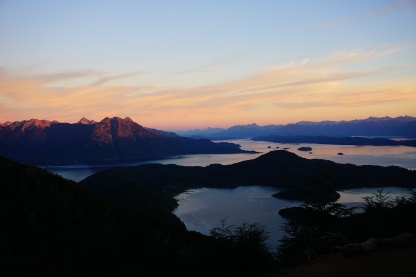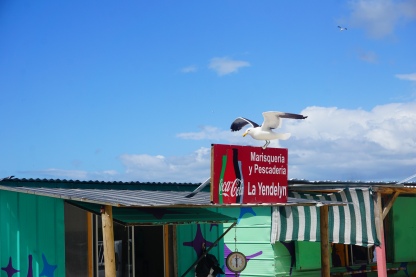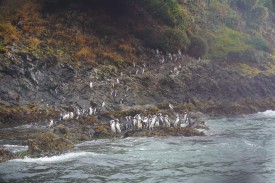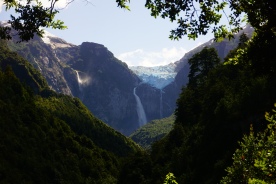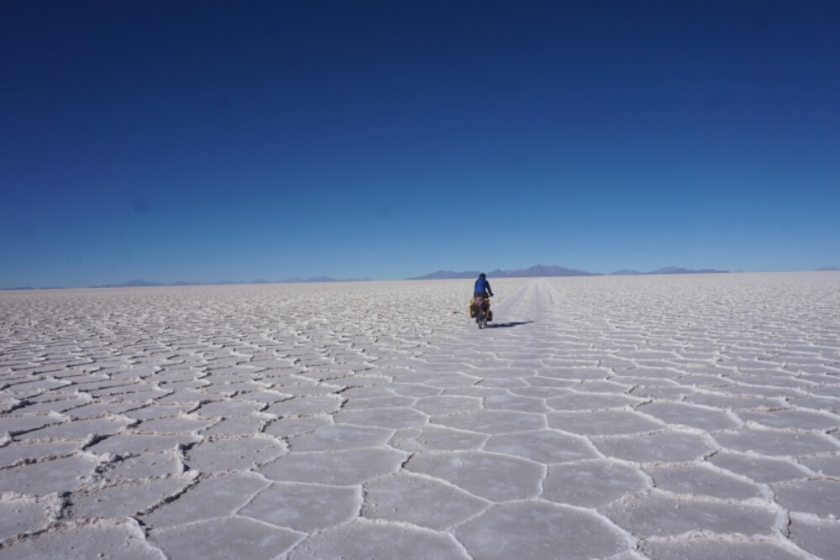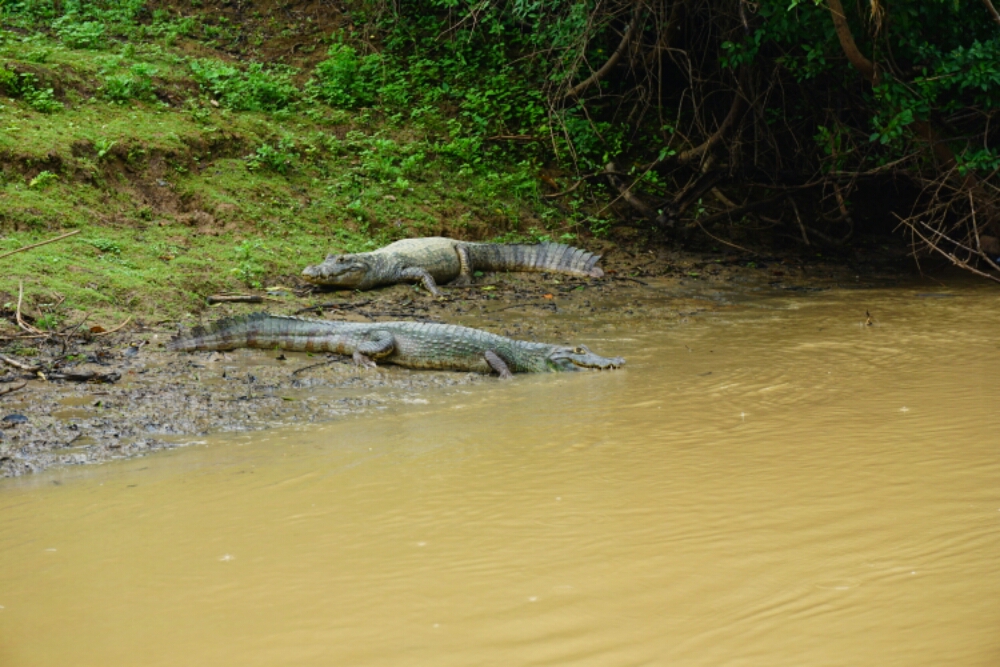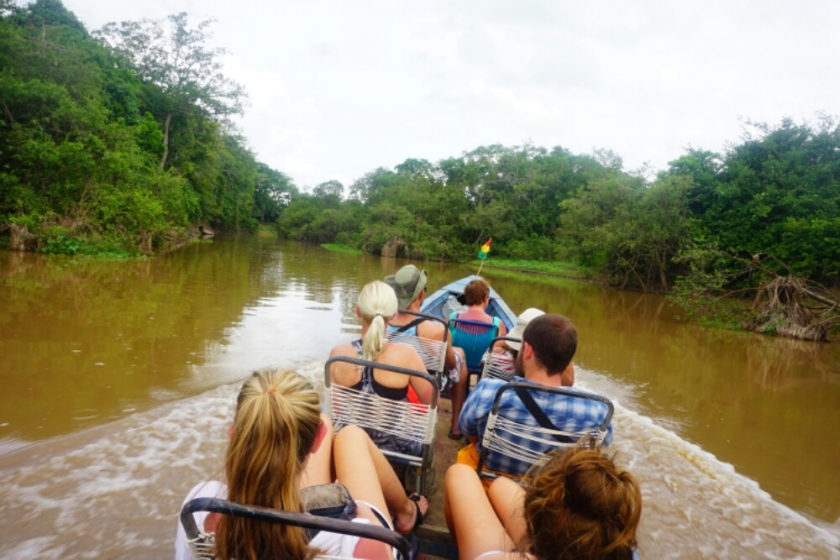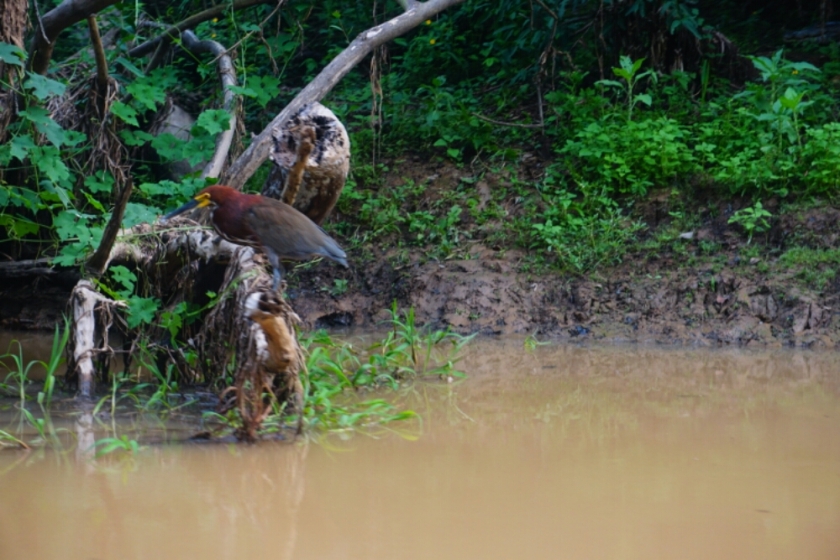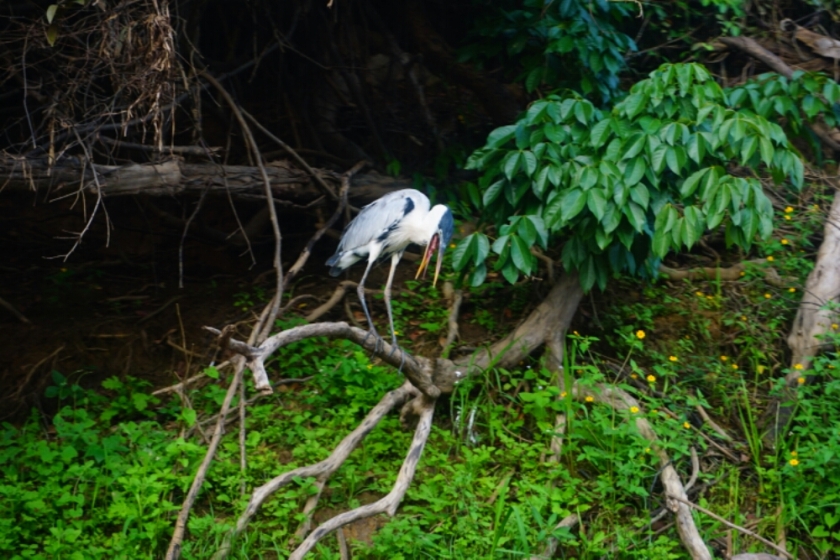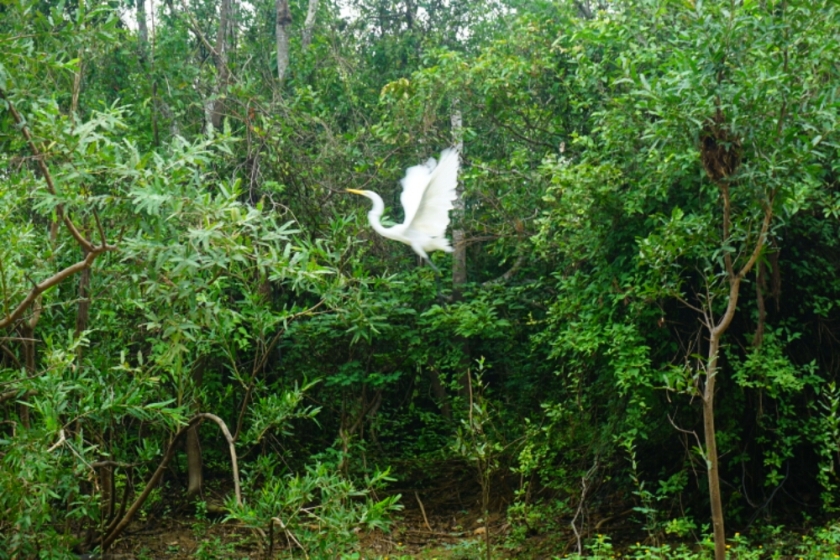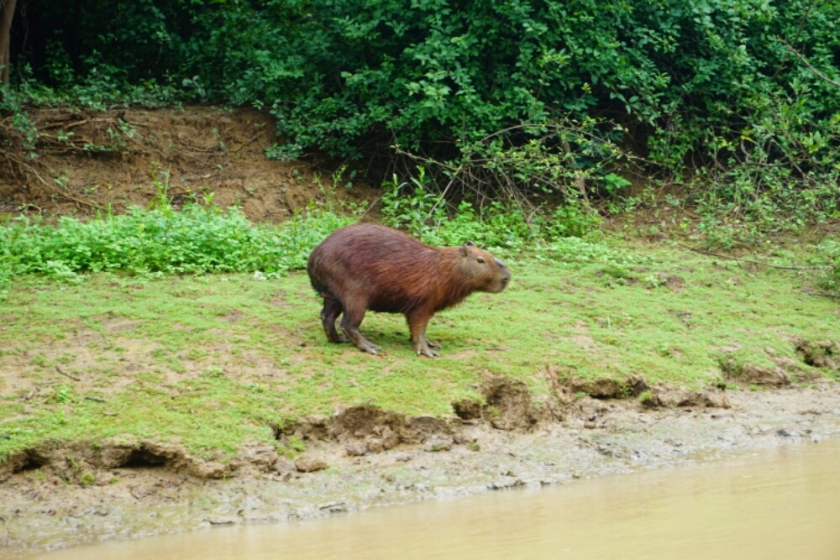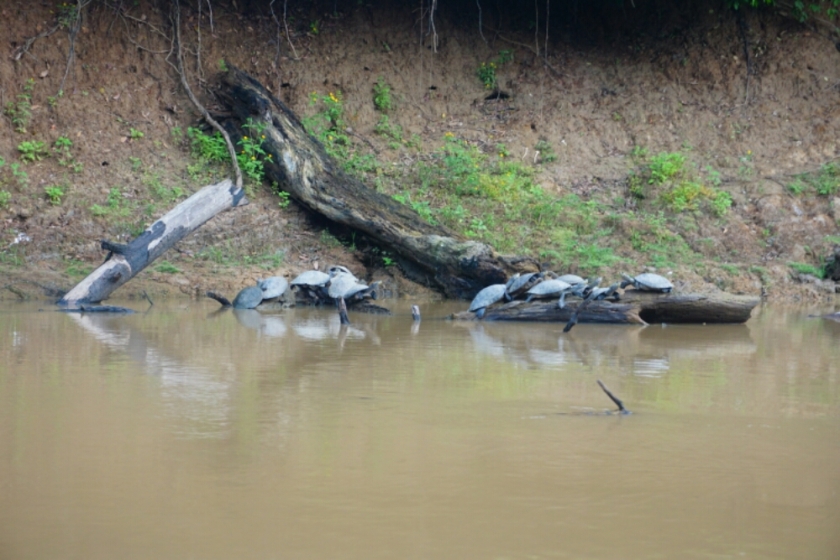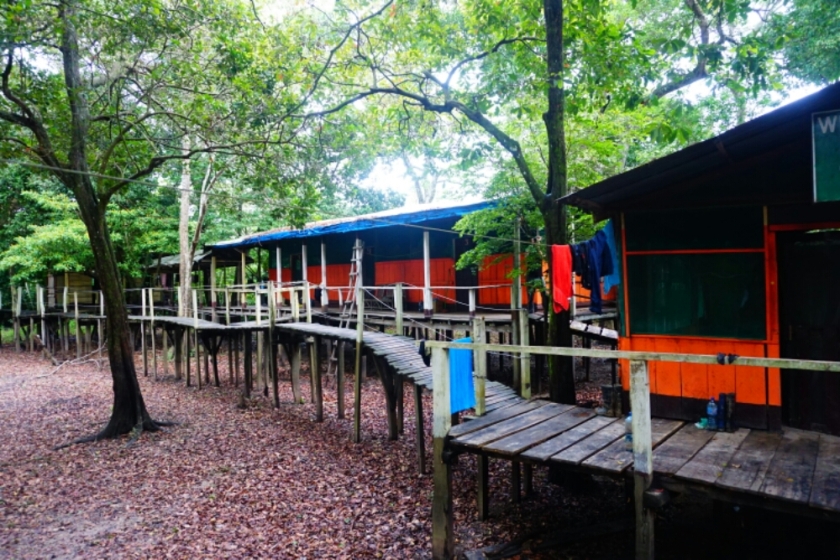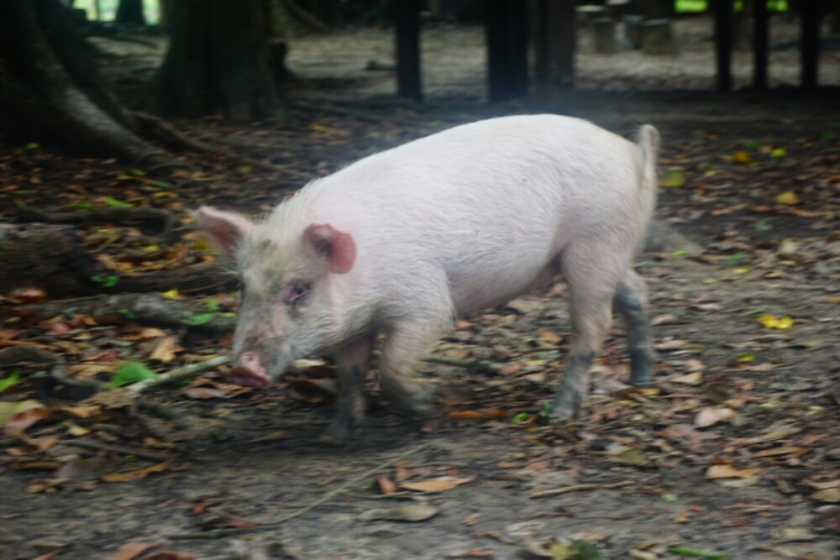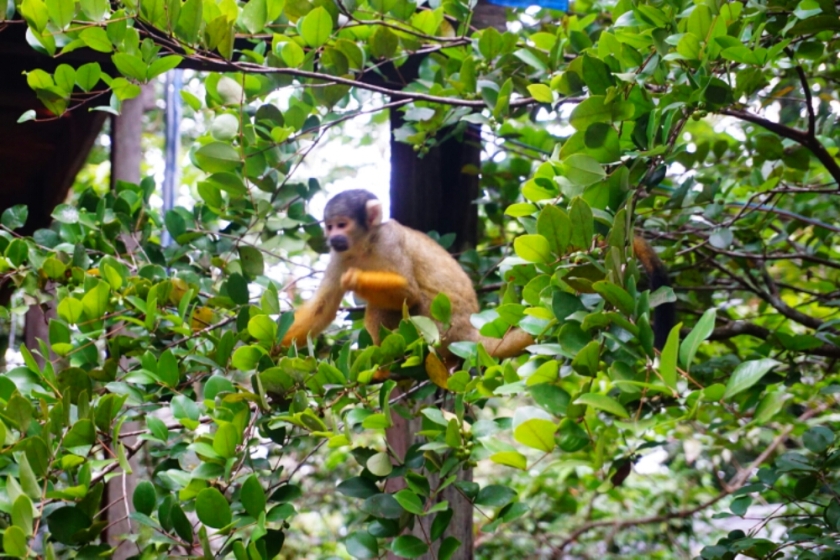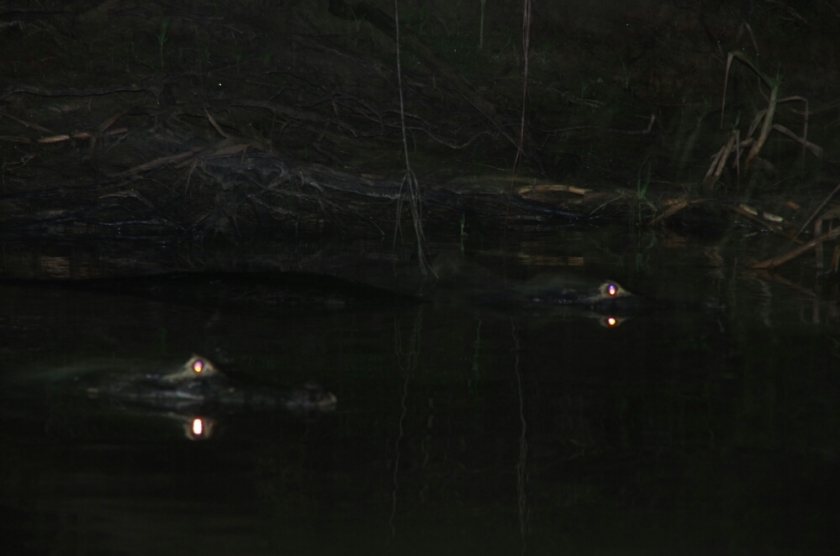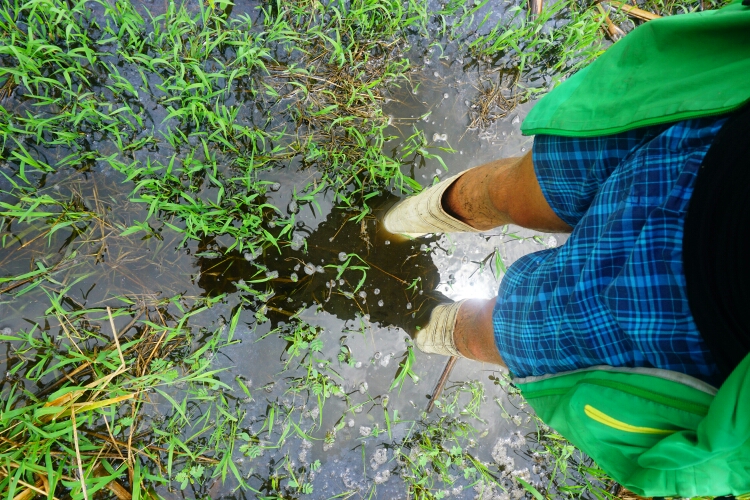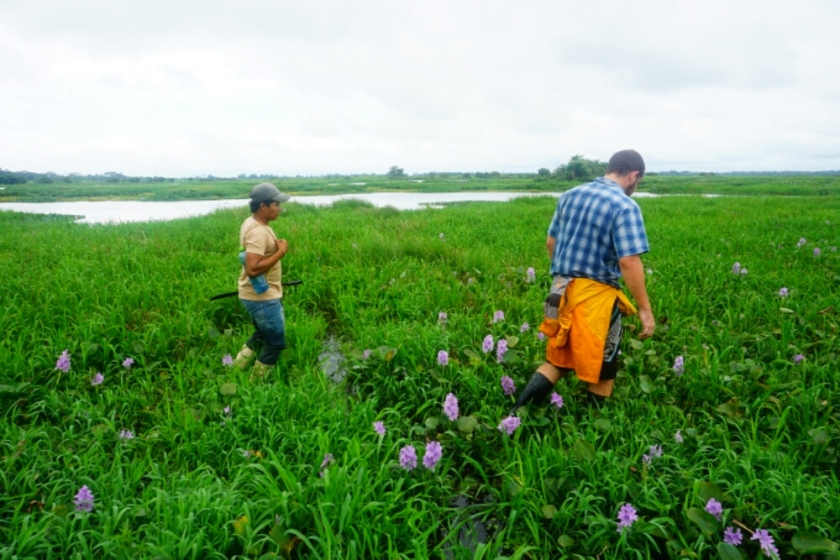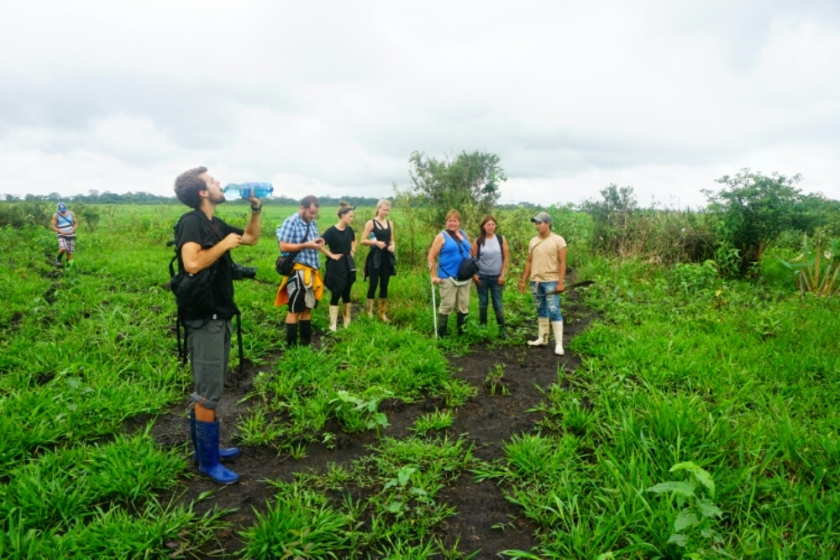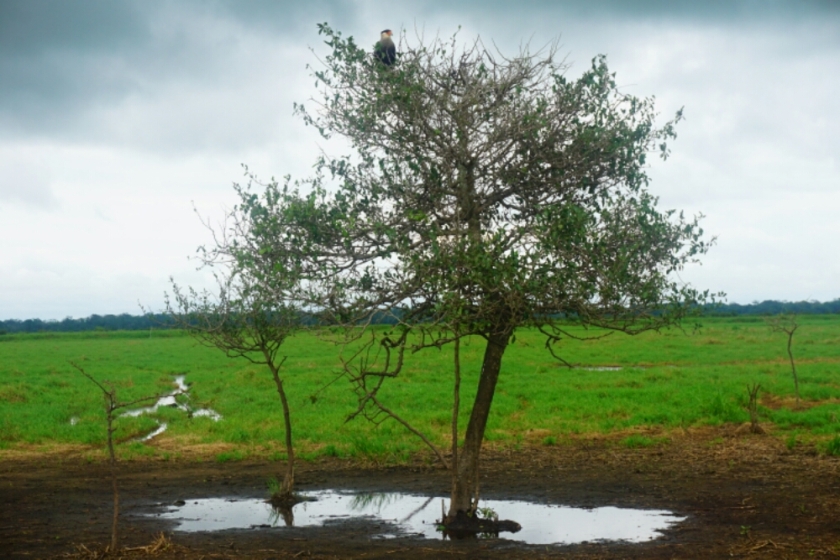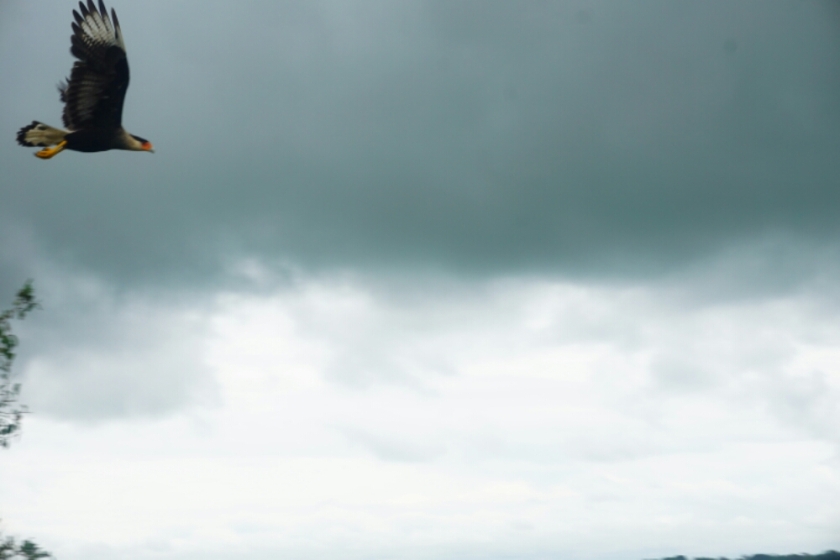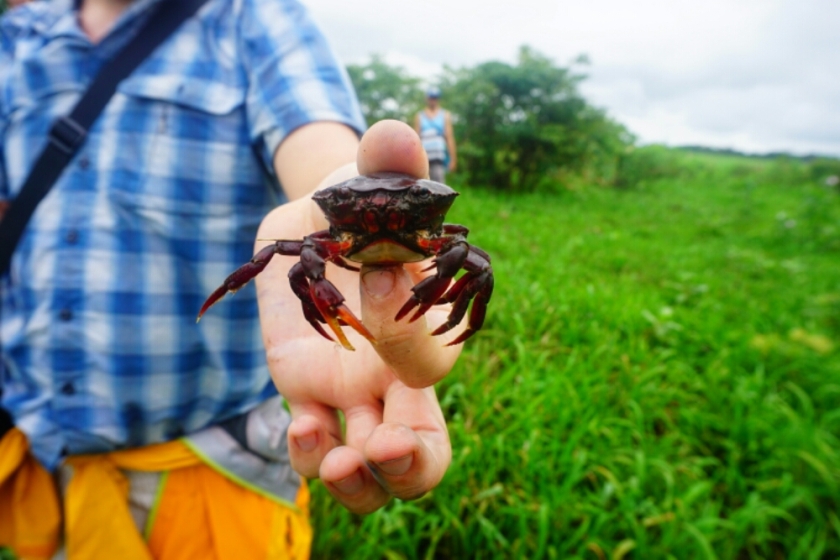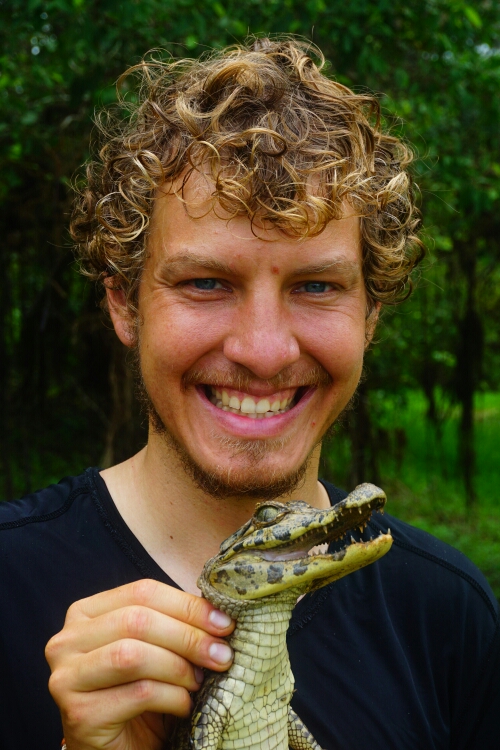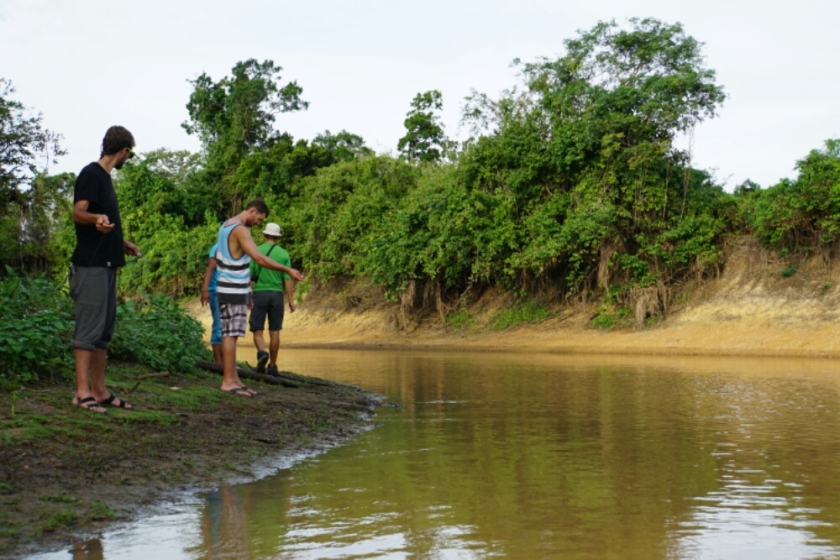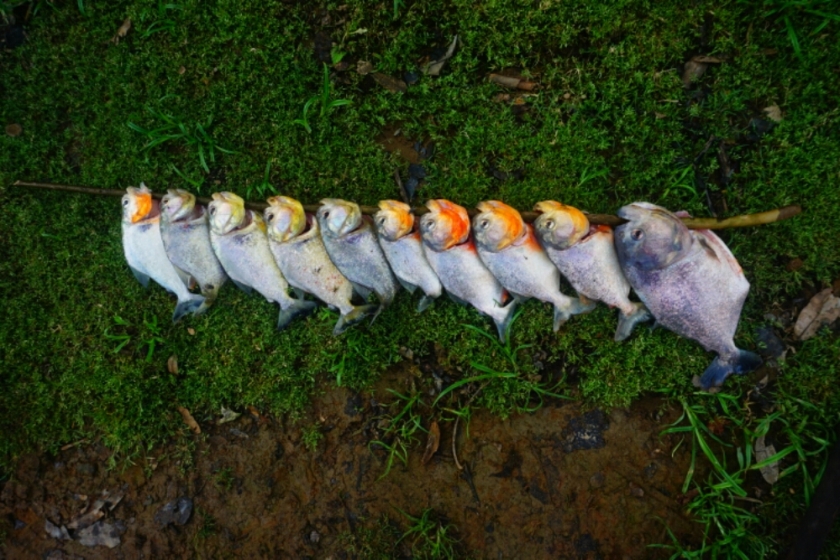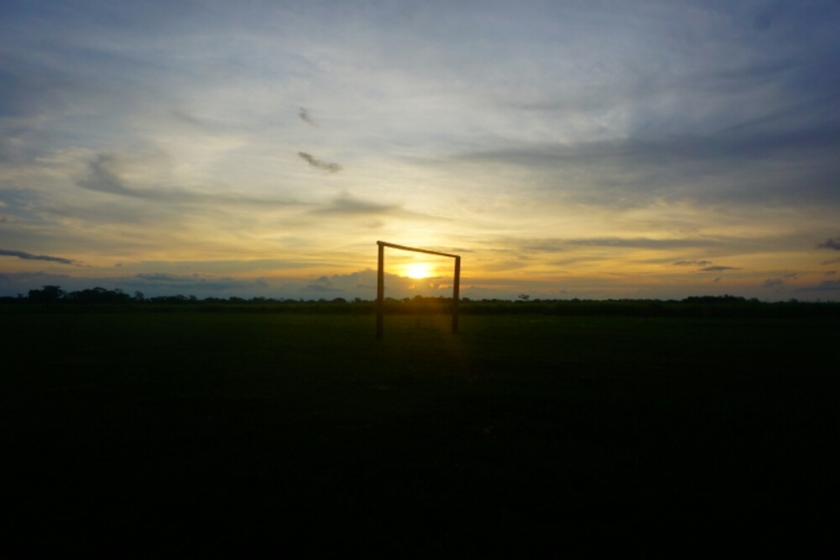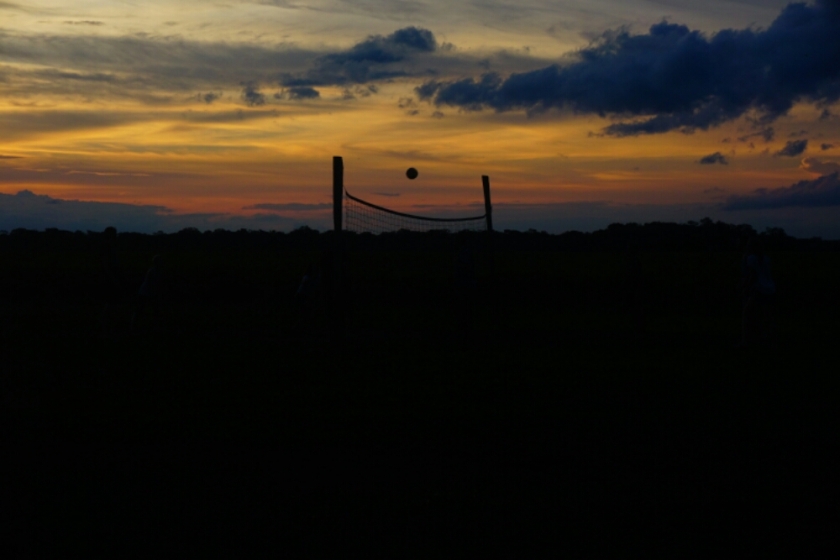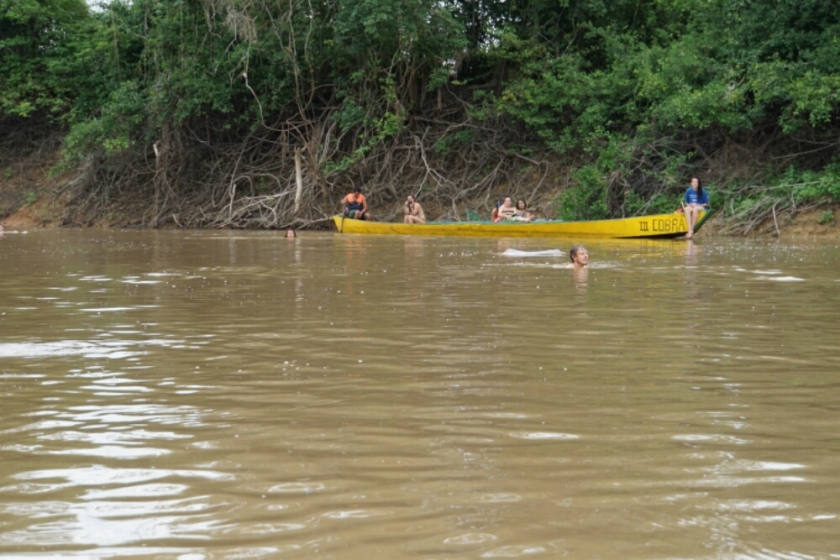The South of Chile and Argentina
The Carretera Austral and Patagonia are two resplendent names on the map of South America, but also the the regions around Temuco, Villarica and Puerto Varas on the Chilean side and San Martin de los Andes and Bariloche on the side of Argentina have a lot to offer. The southwest of the south-american continent is full of blue rivers, lakes, snow-covered mountains or volcanoes and besides cycling there are a lot of trekking options to discover the beautiful nature.
It will be to much to write about everything what I experienced between Santiago and Rio Gallegos, so I decided to pick some of the highlights.
Parque Nacional Conguillío
The name Conguillio originate from the language of the Mapuche people and means water with pine kernel. In the center of this lovely national park is on of the highest volcanoes of this region, called Llaima. In winter it is used for skiing and in summer you can follow the hiking trails passing the high and impressive araucaria trees, nice lakes and cooled lava.
When I entered the park, the volcano was hidden behind clouds, but anyway it was a nice ride and at the end I could see it from the distance while cycling further south.
Villarica and Pucon
When one volcano was not seen anymore, the next one was waiting around the corner. Villarica and Pucon were two nice little cities at the lake Villarica. Between the both I camped directly next to the lake and refreshed myself in the water after a sunny cycling day.
From Pucon I went to some waterfalls and the Ojos del Carburga, a spring pool of a subterranean river, where the water was extremely clear.
Ruta de los 7 lagos, between San Martin de Los Andes and Bariloche
After I left Pucon, I crossed the border to Argentina, where I passed another imposing volcano. A nice welcome present was the free campground just behind the border. Further south I entered the famous ruta de los siete lagos, which has its name from the seven lakes which are between San Martin de los Andes and Bariloche. In this region people from Chile and Argentina spend their holidays.
Bariloche itself wasn’t that nice for me. An ugly town, whose waterfront at the lake Nahuel Nuapi doesn’t invite myself to spent some time. Much more attractive were the numerous mountains in this area, where I decided to discover Cerro Lopez and spend a night at the Refugio. The view was incredible and by looking out of my tent I had an overview over a landscape full of lakes.
Puerto Varas and Isla Chiloe
From Bariloche I headed to Chile again, crossing three lakes with ferries and riding my bike in between the ports. Although it was a little bit expensive it was worth it. On the boat I got to know Ruben, a Argentinian cyclist and in the evening I ended up camping with two more at the lake Llanquihue.
While waiting for a package from Germany I spent one week in Puerto Varas with Constanza, a Chilian girl. She also had some free time and so we discovered the surroundings and also spent two days on the island of Chiloe, where we went to see some penguins.
In this part of Chile and also in the region around Villarica I felt the strong German influence. The Chilian people also use the word Kuchen, which was sold in many places. In Villarica and in Pucon it was possible to buy german bread (panaderia Rostock) and along the streets I could see some german names as labels of different coffee places, restaurants or companies.
Carretera Austral
When I met some other cyclists travelling it was always something special, but the Carretera Austral was so full of them, that we even passed each other without having a conversation. After I left Puerto Varas, I entered the famous cycling route in Puerto Montt and followed it until their end in Villa O’Higgins.It took me about three weeks and most of the time I was cycling with Brian and Andrea, two americans and Jakob, a german. But every day I saw about 10 other cyclists and the ones cycling the same direction were met over and over again.
It was a great time with a lot of wild camping, campfires, dirt roads and a predominant green landscape. One highlight was the hiking of Cerro Castillo, a impressing mountain range, which looks like a castle.
When we arrived in Villa O’Higgins, we were informed that one boat had a hole and needed some time to be rebuilt. Furthermore, due to bad weather conditions, no boat was allowed to cross the lake to Argentina for a few days, so that we met a lot of cyclists (maybe around 40 ) at the campsites in this tiny village, all waiting for the next chance to go on with their travels.
After four nights it was our turn to enter the boat. Afterwards we heard, that the repaired boat of Robinson Crusoe sank, because it hit a iceberg. The passengers needed to be rescued by a helicopter.
Patagonia
My time in Patagonia was dominated by some hikes, beautiful mountains and glaciers. I spent more days hiking than cycling and enjoyed to have some more variety.
Before we reached El Chalten, starting point to hike around the Fitzroy mountain, we had two cycling days with a 6 kilometer section, which is rather suited for walking. But for us it was a welcome relief and another little adventure. Over trunks and stones,through mud and narrow paths it was a very nice part. And after we finished this section we arrived at Lago Del Desierto, where we camped next to the lake and enjoyed the view over the water and the Fitzroy in the background.
The hike over the paso del viento around the mountain Huemul was definitely one of my hiking favorites. With 11 other cyclists and one german backpacker we had four beautiful days in the mountains, walking over glacier ice, astonished by the huge ice field and observing swimming icebergs.
Cycling out of El Chalten I got to know the face of the Pampas with nearly no trees but thousands of yellow shrubs.But not just the colour changed,but also the intensity of the wind. With a solid tailwind I was pushed east, while some days later I was confronted with a head wind, which I had totally underestimated.
Every 3-6 years there is a special natural event happening at the glacier perrito moreno. Due to the climate change most glaciars are shrinking, but this was near El Calafate is growing. The ice wall of a height of around 60 meters is moving forward until it reaches a peace of land on the other side. That leads to a congestion of the meltwater on one side. When the pressure gets to strong, the water pave itself a way under the ice, a hole which gets bigger and bigger until a ice bridge is produced. Due to the weight of the ice bridge and the flowing water underneath, it leads to the point where this bridge breaks and falls into the water. On that day, when this spectacular took place again, I visited the glacier, but unfortunately 40 minutes too late. Anyway, it still was impressing to see this long huge wall of ice and from time to time other big parts fell into the water with a loud crashing noise.
Along my way down south I heart of the beauty of Torres del Paine over and over again and I was aware that it was full of tourists. But most of the time there is a reason for the tourists and Torres del Paine is definitely worth to go although the treks are really full. From some locals I got to know that the airport will be opened to international flights in the next year and the park rangers talked about an increase of 30% compared to last year. I hitchhiked from Puerto Natales and was give a ride by a immigration officer and a family, which first took me to some places off the beaten track and then gave me some snacks and drinks for lunch.Most of the time it’s really worth to hitchhike. For the hike itself I decided to do the shorter „W“-Trek, which included most of the highlights.
With a beautiful ride with the wind in my back I cycled the last two days of my trip from Puerto Natales to Rio Gallegos. It was a lonesome part of the ruta 40 with nearly no cars.I was singing loud with the songs I was listening to, I was observing the wild life around me and I felt happy to have done this amazing tour.
An End Has A Start
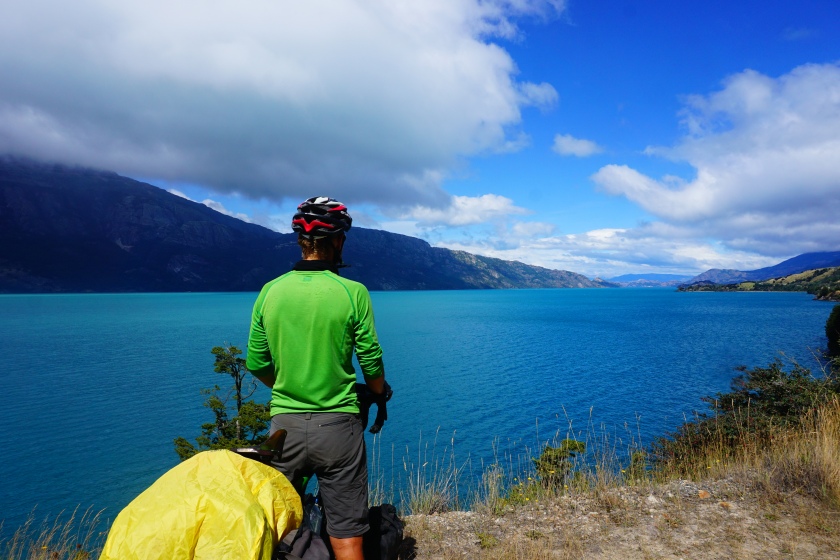
My journey through Latin america had an end, 11 months on my bicycle from Costa Rica to Patagonia in Argentina. How was is? What was the most beautiful place you have seen? What was the most impressive experience? How is it to be back? – That’s what friends and family asked me during my first few days back in Germany. Questions that can’t be answered with a short statement, cause my feelings are too diverse and places and experiences were to different to compare them.
But what I can say, is, that the new start won’t be that hard for me. I soaked up a lot of inspirations, ideas which caused a lot of motivation to put into practice. I found out that all the things I learned need time and space to develop, personal long-term projects which can’t be done during this kind of journey, where I was daily confronted with new topics and new people in different places with different landscapes. It was diverse, refreshing and surprising, but it was not necessary a suitable environment for sustainable development, but rather a breeding ground for insights, for a new mindset, an environment to increase the consciousness. The current question is, what I will do with all these thoughts, how they can enter reality and my daily life. And this is what makes me looking forward to what will come.
New Year, Valparaiso and Santiago
You do never travel alone – besides the people, who follow my travel from the distance, there are more cyclists travelling on the road than you think. The first I met in Costa Rica, two brothers from Argentina and along my path towards all the countries to the the south I’ve got to know over 100 more. Some are cycling north, others south, some are cycling for two weeks, others already for years, some people you meet over and over again, others you will see just for a few minutes or even seconds if you don’t stop to chat. You add them on Facebook, like their travel blogs, follow them on Instagram. With some you decide to pedal together for a day or weeks, unforced, still independent, but happy to share experiences along the way.
So the idea came up to meet in Valparaiso for New Years. 6 cyclists out of around 20 were able to make it in time on their way south. After Christmas and crossing the Paso Aqua Negra, I was late to arrive in time at the agreed place and I wanted to skip the rather unattractive part in between La Serena and Santiago. So I took the bus and this time I first talked to the driver before getting a ticket. And due to the last minute purchase I got a good discount on my ticket and everything went good. I went out in La Calera, where I was invited for lunch and a drive around the area. The guy was the owner of a restaurant, a olive plantation and a transport company, a big fan of Marilyn Monroe and Elvis, collects old cars and motorbikes and seemed to belong to the upper social class of Chile.
The next day I met Vincent again, a canadian cyclist who started from his home town. Together we cycled the last few kilometers to Valparaiso, taking the road over Con Con along the ocean.
Suddenly I spied one cyclist at the boardwalk, then a second and finally 5 in total. By accident our new years bicycle group run up to 11.
The night we spent on Cerro Concepción in Valparaiso, where we had a good view to the firework. Nearby a DJ was playing music, good music, outdoor und a tree, so we danced through the night until the early morning. The next two days we discovered Viña del Mar and Valparaiso, went for a swim in the sea, tasted some local food and walked trough streets full of colourful graffitis.
Big city life with a bike
After one night in the mountains and one night in the Casa de ciclistas in Los Andes, I arrived in the capital of Chile, Santiago. From all big cities during my travel my favourite referring to the friendliness for bicycles. The first evening a critical mass of about 4000 people rode their bikes trough the center and some suburbs, a great start to get to see some parts of Santiago. A bicycle network of 40 kilometers provide a better infrastructure for cyclists than in a lot of German towns. Bike rental stations and guarded bike parking spaces can be found in the city. Mario, a chilenian bicycle activist gave me a map, designed for cyclists with all the important information – great! Besides that the city is close to the ocean and the mountains, has a lot of parks and offers various cultural and culinary sides to discover. But after 5 days I was replete of the hurly-burly and longed for calmness and more cycling trough nature. I went to the bus terminal and went over night to Temuco.
Christmas in the Andes
Kunstmann – das gute Bier – I’m sitting in La Calera in a restaurant with the name La Estacion, where they have german beer. For me a fresh jugo de frambuesa (raspberry juice) is waiting to be consumed, while the Beatles are playing. And just some minutes ago I was invited by the owner of this place to have lunch with him. On top he is responsible for tourist and culture informations in this region.
While I’m enjoying my day off, I will let you know how I spent Christmas and the last few days.
La Noche Buena (Christmas Eve) I spent in Rodeo, with the two lovely owners of the place called Clandestino and Arved, a german traveller. We went out for dinner at a fancy place with good food and a dancefloor out of sand. On Christmas morning I had a relaxed breakfast with fresh bread before I went on cycling.
Another Andes crossing, this time from around 1500m to the top of the pass Aqua Negra , 4735m. The first day I met wild horses and camped on 2700 meters. Me and my tent survived a hail thunderstorm, which was going down on on my little housing with an unbelivable loud noise.
The next day I just cycled half a day to camp on 3900m, where it was cold, but not as cold as it would have been near the top.
The highlight of the crossing arose during my third cyling day. It was amazing: ice and snow and magnific mountains surrounded me and when I crossed the top, the chilian side was even more beautiful. I was totally flashed by the beauty and when it became time to set up my tent I arrived at a lagune, where I found the best camping spot of my whole travel.
I arrived in Rodeo, where I visited a Observatory learned a lot about all the things which are million light years away from us, saw the ISS passing by and for the first time the cross of the south.
My accommodation in Vicuña was owned by a woman who used to live in Stuttgart nearly 20 years ago. I found a facecloth on my bed and had a german breakfast with Christstollen and a small Rittersport choclate.
The big 10 defined by André: Frequently asked questions
Today I listened to the last episode of Sanft & Sorgfältig for this year, a german podcast with the musician Oli Schulz and the TV star Jan Böhmermann. Inspired by them and due to the first exchanges of words with interested people along my way I will tell you about 10 frequently asked questions and will respond them.
Sometimes I get a little bit tired of answering these questions over and over again, but I started to collect them to see what is of interest for the people, meeting a cyclist like me traveling on its bike. I also observed that the questions do differ depending on the country and the level of living. While in poorer countries the local people are rather interested in the money, tourists from Europe may rather beinterested about my performance. Other cyclists rather look for the equipment.
1.Where do you come from? Where are you going? When do you start your travel?
Of course the origin and the direction of traveling are always the first things people want to know. Sometimes you switch from Spanish to another language afterwards. I always have to emphasize that I’m from Germany, but that I started my travel in Costa Rica. If I’m not doing this, I sometimes got the question if I started my cycling in Germany. After they know that I’m started in Costa Rica, their eyes get big and there face express an astonishment before they want to know how long I already have traveled.
2.How many kilometers do you cycle per day?
After the origin, the starting point, direction and time, this one might be the most frequently asked question. In the meantime I have developed a routine in responding to that one: It’s totally different because it depends on so many things, like the road conditions, the temperature and humidity, the altitude, the wind conditions, my personal feeling and motivation and of course the amount of meters which I have to go up or down.
3. Where do you sleep?
My answer to this question differs sometimes, because some people don’t know what couchsurfing or warmshower is, nor Casa de Ciclistas. In my map I always note where I stayed for the night and what kind of place it was. I have not evaluated it so far but I suppose that I spent most of my nights in my tent (wild or payed camping), followed by payed accomondations (most of the time hostels, rarely cheap hotels). From time to time I stay with local people (Couchsurfing, warmshowers, Casa de Ciclistas or invitations). The decision depends on the outer occurrences, on my mood and if I want to take a shower or if I need Internet or electricity.
4. Do you cycle/travel alone?
This question I’m always asked when I cycle alone and there is obviously no other cyclist. So I confirm but always admit that I’ve already cycled with others for some time and that there will be more cyclists I will meet to travel together for a while.
Sometimes I enjoyed the companion, but I also like the bigger liberty when I travel on my own. Traveling alone feels to be much more intensive, cause I got to know more people and speak more spanish. An important point of traveling with other cyclists is, that you can share your experiences with somebody else. And if all the other aspects do fit very good, I definitely prefer to cycle with another person.
5. Are you not afraid when you travel in this manner?
„No, I’m not afraid“ was my answer and depending on the person I went deeper in to that topic. I dealt with the topic of fear during my travel several times and developed another point of view at this topic. As a result my fears diminished during my travel.
I still take care and I’m looking for camping place, which can’t be seen from the road for example. Or I drive concentrated when I enter big cities with a lot of traffic. But I feel comfortable in this situations and fear doesn’t affect my feelings.
5. Did you have any bad experiences with raids or thefts?
Until some days ago I could always answer, that I had never had any problems. But in the bus terminal of Tucuman people tried to steel stuff from me, but they didn’t succeed.
I’m a person who believe in the power of positive thinking and so I think that I can keep away these things by control my thinking and not giving space to bad experience imaginations.
6. How much weight do you carry with you?
I don’t exactly know how much weight I carry with me and the first time I got to know how much kilos my bicycle is, was when we had to pay per kilo, while we transported our bikes in the train from Oruro to Uyuni. So now I know that the weight of my bike is close to 20 kilograms. A stable frame out of steel, solid rims and the Rohloff shifting system might cause the weight. The amounts of kilos I carry in my bags do differ from time to time, depending on the provisions I carry with me. Over the months I reduced my weight more and more, so that I think that I’m below 25 kilos now, but to be honest I don’t know.
7. Do you have trained in advance for your travel?
Not really and I also tell the people that in my opinion everybody can travel with the bicycle. It is a matter of habituation and you train yourself during the travel. Like with a lot of things you can start with small distances and increase the daily kilometers step by step. I also meet people, who just cycled 30-40 kilometers per day.
Me myself was always doing sports and I also cycled quite a few kilometers the year before, but I haven’t done it to be fit for my travel.
8. How much money does your bike costs?
Here I’m careful with my answer and most of the time I didn’t state the right amount. Sometimes I downplay and name a price which is much lower than the real value. I guess that in some cases by bike is more expensive then several cars here in the streets and I also don’t like to talk about money that much.
9. Did you have problems with your bike?
Well, yes, but no damages, which could be solved. Flat tyres and worn brakes belong to a long journey. While I had a lot of flat tyres in the beginning, it now became very rare. From the first day in Peru until today I just had one flat tyre.
The most serious problem was, when the screw of my rear bicycle rack broke so awkward, that I was not able to get the rest of the screw out of the thread.
A one-sided crack of a chain link and lost screws of my Ortlieb panniers issued a challenge to me.
Besides these topics, everything went well with my bike.
10. When do you go back to Germany?
I don’t know by my own and it does feel good to not have a date which does limit my journey. I will decide it spontaneously depending on cheap flights back to Germany or Europe. Currently my return seems to be in the middle of April.
There will always be a solution
Its about noon, more then 30 dregres, intense sun and a light wind, which will get stronger over the day. I’m sitting in a fancy bar next to the lake of Rodeo in Argentina, with an amazing landscape around me, the green water with the snowy andes in the background – I feel ready for Christmas surfing. Today and tomorrow I will spent the days here, away from the stress of the cities, where people try to get their last presents for family, friends and relatives, apart from cold temperatures (although this year seems to be the warmest ever due to global warming) and without any rain. I have some days off of cycling and I’m happy to practice some windsurfing!
Looking back, the time between Salta and here were full of ups and downs, and I’m not just referring to my paths on the road, but also to tasks, which had to be solved.
One thing which occupied me was that I was running out of money, because my credit card was not working at the ATMs nor was it possible to pay with my VISA. But as I got to know during my travel: There will always be a solution as long as you believe in it. And so there was. After over a day of trying to find a solution, I finally got the proposal to try a western union transfer. I registered in the internet, transfered money, received the money in the local post office, so that finally I could rent the surf equipment.
Some days before at the bus terminal in Tucuman, people tried to steel stuff from my bag at the handlebar, but I noticed early so that nothing was stolen and the thieves left.
The third bad thing that happend, was the transport of my bicycle: I bought a ticket and asked for a transport possibility of my bike. It was confirmed by the ticket seller but the bus driver declined, so that I was not allowed to take that bus. I changed my ticket, was told that this time my bike could go with the bus, but at 12:30 in the night there was again no space for my bike in the bus. So I spent hours of waiting in that bus terminal with the result that I had to find a hostel in the middle of the night. The next day I discussed with the people from the bus company andesmar, who were not willing to give me back my money! I was forced to wait until 5 oclock at the next day, when the shift of the guy started, who had sold me the ticket. Luckily he gave me back my money and I was able to find another company, where the bus driver was ok with the transport of my bicycle.
Very energy-sapping all the discussions, the waiting and hoping of a working transport. Traveling with the bus in Argentina is definitely not fun with a bike.
But travelling with the bike in the north of Argentina is definitely fun. From Salta I decided to take the road to Cafayate via Cachi, where I crossed a beautiful valley which went up 2200 meters to a pass where there is the entrance to the national park Los Cardones. I nearly ran over a snake, a kind of dear crossed my path and the mountains were primped in different colours and huge cactuses again.

The second day I met up with Arved, a german traveller on his motorbike, who I already had met in Salta. The last few kilometers up the hill he was pulling me up the mountain. We camped next to the laguna Brealito, had a swim in the lake while the last rays of the sun shine on the water, made a campfire and enjoyed the calmness of this place as well as the amazing ceiling with all its stars.

On that altitude at that season the climate is dry and hot, so that my throat needed some water every few kilometers. On top of the heath the road from Cachi to San Carlos was not paved and offered a lot of unpleasant washboard. When I was back on the tarmac, a sea of white butterflies welcomed me and before I arrived in Cafayate I visited a vineyard and bought a bottle of white wine, which I shared with Arved in a hostel in Cafayate.
From there we went to a canyon, close to the town, which we crossed half climbing half walking. Some goats showed us there climbing abilities, before we arrived at a first waterfall, where we jumped into the refreshing water!
I left Cafayate with the bus, due to several narrations that the part down to Mendoza is not that interesting and to have more time in Patagonia. The bus story is already told and I was very relieved when I was finally in the bus to San Juan.
I want to cross the Paso Aqua Negra, so I headed north to San José de Jachal. The path trough another beautiful valley to Rodeo was just a half day trip and so I arrived in the calm village about noon.
I got to now some nice people which whom I spent some time with. Slackline, soccer, reading, hanging around and the my issue with the money dominated my last few days!
Today 8 months of my travel have already passed! Time pass by very fast and this year was definitely the one I experienced a lot, met awesome people, saw beautiful places. But still I miss Germany sometimes, my family and my friends. Have some happy christmas days, enjoy the atmosphere, take your times to relax and reflect. I’m looking forward to see some of you next year!
The world is beautiful
It seemed as if somebody threw some buckets of colours over the mountains in the north of Argentina. Amazing face of the world, unbelivable composition. After some relaxing days in San Pedro de Atacama I found my way to country number 8 on my way down south in Latino America. A lonesome region on high altitude, a dry desert, lagunes and salt lakes, decorated with vicuñas, wild donkeys and Llamas. But this time I could lift my eyes and observe my surroundings more than on the Lagune route in the south of Bolivia, cause this time the road was paved and so my joints and my affected but we’re happy to recover a bit more.
From San Pedro I hitchhiked the 2000 meter uphill until the point I came from Bolivia, a truck from Paraguay gave me a lift and so I found my bike inbetween cars, which are transported from Iquique at the coast of Chile to Paraguay. Heaps of these trucks drive this 2000 kilometers way several times a month.
So I was on 4600 meters of altitude again to start my way through the desert on the so called ruta del desierto. The wind was already there but this time it was pushing me into the land. Due to the advanced day I searched a shelter after a few kilometers in this impressive landscape, which appeared to be like in the mars or moon. Next to a lagune with some ducks a found a small wall which served as a shelter. The night was bitter cold, so that my water in the bottles were totally frozen and I also felt a bit cold for the first time on my travel.
On day 2 the landscape presented me rock constellation, more lagunes and after I arrived the highest point of Paso Jama on over 4800m it started to go down. Finally I arrived Argentina and although officers at the border worked slowly like rusty trains, everything went without any problems. Looking on a map I realized that I had wrong distance kilometers in my mind and so I augmented the daily kilometers to reach Purmamarca within 4 days. At the Laguna Ana I found an old bus behind a small hill. I felt like in „into the wild“ and also the interior was not as comfortable as in movie I decided to camp inside this rusty vehicle.
The first little village I arrived was Susques. A calm place were I could by some fruits and chocolate to get some power for the next kilometres. I went up some hundred meters before I went down a beautiful valley with cactuses and weird rock formations. It felt like in the wild west. Some kilometers further the valley opened for the great plain with the Salinas Grandes. But before I entered it, I set up my tent next to an abandoned house. From there I could observe a rising thunderstorm, which arose to an enormous spectacle during the night, the beautiful ceiling full of stars with a play of lightnings at the horizon in the distance.
Through the plain to the Salinas Grandes and up another 700 meters to the top of the last big mountain, I had my first lunch in Argentina: A small empanada de queso, humanitas and for dessert goat cheese with cane honey. The last ascent was quite tiring but the way down on the other side a real pleasure. The next valley was amazing. First of all the canyon and more cactuses. And at the end, the colourful mountains round me. Blue, red, white, orange, black, I couldn’t stop to marvel.
Finally I arrived Purmamarca. The evening I spent with a guy from Buenas Aires, we had some beer, shared a pizza before we had a red wine from Mendoza with some cheese back in the hostal. The next morning I had a walk inside thesencolourful mountains.
When I went down to San Salvador de Jujuy, the landscape changed a lot. More and more plants transformed the natur into a green forest, it became more humid and more clouds covered the ceiling.
Sand, Salt, Rocks and Wind
San Pedro, a oasis in many regards after a week of tough cycling in the South of Bolivia. The famous route of the Lagunes on an average altitude of 4300 meters, without many possibilities of food and water supply, heaps of climbing, lots of strong winds, cold nights, intense sun, dry air and paths covered with sand and rocks. It was definitely the hardest section of my way down south so far. BUT, it was so worth it! Every single day the landscape gave me new energy! But let’s start in Oruro, where I met Sam again to take the train to Uyuni!
It was a beautiful travel trough on the flat altiplano. We saw a thousands of flamencos in the huge lake of Poopo, before the sunset atmosphere encased us with a wonderful play of colours.
A interesting spot in Uyuni were the old trains whose shapes out of steel rust in the surrounding sand and create an special atmosphere especially during the light of a further sunset.

We left to the Salar de Uyuni where we camped in the middle of nowhere on this huge white field of salt. It was very windy, so that we had to wait for the sunset again to put up our tents afterwards, when the wind was subsiding.
We left the middle of the Salar, but camped another time on the salt, this time mixed with clay and therefor easier to mount our tents into the ground. In the night a sandstorm swept across our housings but both tents withstood the force of nature.
In San Juan Sam decided to go directly to Chile, so I was on my own to proceed towards some days of adventure in the mountains of Bolivia. After some comperative easy kilometers on another plane salt lake I faced the first climb. It was horrible to ride, so that I had to push my bike several times. I first glimpse on what was coming in the next few days. I imagined to arrive at the short section of the main road but I ended up settle down for the night a few kilometers before.
The second day I arrived at the first lake, Laguna Cañapa, where I observed the birds, flamencos and seagulls, before I cooked myself some mashed potatoes.

For the night I arrived at the Laguna Hediondo where I asked to camp next to the Ecolodge de Los Flamingos. But instead I was offered to stay inside. They even provided me water and breakfast for free. Very nice people, so that I gave them my beani as a present when I left in the next morning.
On my further way I saw another cyclist in the distance nd when I got closer I saw that it was Camille, a friend I’ve been hiking with near Cusco. He had a problem with its pedal, but first we cycled together and found a nice shelter to camp in the evening.
To get out of the tent in the morning some motivation was always needed, cause the temperature at night and in theearly hours wasn’t that comfortable. During the day I passed some rock formations, one of the the árbol de piedras, a rock which looked like a tree.
The way down to the laguna Colorada was very hard to ride, the destination close but it seemed not to get closer. But finally I was next to the lake, where the national park „Reserva National de Fauna Anadina Eduardo Avaroa“ started. Inbetween the day the Camille had further problems with its pedal, so that he arrived after me with one of the numerous trucks, which drove around the tourists.
The pedal was fixed, welded by a mechanic and this in the middle of nowhere. After a night in the Refugio we started together, but after 10 kilometers the pedal brake again. So we had a last lunch together, before I went on climbing up the highest section of the Lagune route, while Camille went back to his mechanic.
After another tough drive I arrived the geyser field. Steam was coming out of the earth and was blown away by a strong wind. Behind an abandoned house I set up my tent, with 4880 meters the highest point I ever camped on.
The highest point I ever ride my bike followed the next morning, 4926 meters. After I reached the pass it went down to the Lagune de Chalviri, where a thermal bath waited for me. I directly rode my bike next to it and jumped in to relax. Two hours long I enjoyed the comfortable water and the nice view onto the Lagune.
It was still early and so I decided to go on to the next highlight, the laguna verde and the laguna blanca. After another climb with headwind it went down again. Due to some sandy parts I was more sliding than riding down my bike. And when I arrived I was happy again to have found a nice spot to camp with a beautiful view over the Laguna Blanca.
The Laguna Verde was just 2 kilometers away from my sleeping spot and at the time I arrived the outlook full of people. Some of them coriously started to ask me questions, below them as well other cyclists. And so again I felt like a wild animal or an mascot with whom you take fotos with. But the people were all friendly and took a foto of me.
The last day in the south of Bolivia, heading to Chile and San Pedro de Atacama was less easy to ride. The wind already woke up in the morning and my imagination about the last pass was much more relaxed. On top my legs were quite tired after the last 6 days. The border was no problem again and finally I was on a paved street again. 2000 meters downhill sounded on tarmac sounded like a dream, but another strong head wind significantly prolonged the time to arrive in the Oasis of San Pedro de Atacama!
Finally I arrived back in the civilisation, with all culinary amenities and a hot shower. It was a great ride and great motivation to do similar treks, apart from the main roads with significant sceneries around!
Skin to skin with the Pampas
I’m surrounded by thousands of little lights in the darkness, some steady at the ceiling, others blinking around me and some seems to be underneath. The visual appearance is accompanied by a cloud of constantly humming noises sometimes drowned by croaking noises. I’m sliding slowly through this atmosphere until… somebody puts on a flashlight and I’m back in reality, back on the river, surrounded by sounding insects, the stars of the sky and the blinking lights of humming birds, whose lights are reflecting in the water.
I’m surrounded by thousands of little lights in the darkness, some steady at the ceiling, others blinking around me and some seems to be underneath. The visual appearance is accompanied by a cloud of constantly humming noises sometimes drowned by croaking noises. I’m sliding slowly through this atmosphere until… somebody puts on a flashlight and I’m back in reality, back on the river, surrounded by sounding insects, the stars of the sky and the blinking lights of humming birds, whose lights are reflecting in the water.
3 days and two nights we spend in the Pampas, near Santa Rosa, in, on and close to the river Yacuma. After a three hour bus trip we changed into a long boat which was head a powerful motor at the back.
The riversides were full of animals and so we saw heaps of alligators, turtles and huge birds as well as some capibaras and caymans.
We were staying in one of the lodges along the river, where we had further animals to observe, like Luisa, the pig of the house and all the little monkeys, which were frolicing around.
In the first night we entered our long wooden boat again to observe the alligators by night. Their eyes reflected the lights of our torches, so that we could see all the yellow lights all along the river.
Our guide Gary fetched a little baby alligator so that we were able to hold it and feel the texture of the flaky skin.
The next morning we discovered the area next to the river, traversed head-high reed, small rivers with the water up to our knees or swampy pont-water. The idea was to find an anaconda, but although we were trying hard with the help of our experienced guide we couldn’t find one. But still it was an adventure and we saw an eagle and further animals.
Notice the king of the air in the treetop.
Gary pulled another alligator out of the thicket, this time a little bit bigger then the one from the night before.
The afternoon we were in the river again and this time we stopped to fish Piranhas. It was amazing how fast we were able to fish them, not 5 minutes passed as I got the first piranha in my line. But it remained the only one, although it was always able to feel how the fish nibbled on the meat. At the end we had enough for dinner. At the end we found out that they just had a little meat inside, but it was tasting good.
Before going back to our lodge we stopped to see a beautiful sunset over the Pampas.
The last day we were riding on the river again to find a spot where we could swim with the river dolphins and after a few minutes of searching we really found them. They were not that trusting as I thought they would be, but here and there they showed themselves, emerged, dived into the water again and passed us without us noticing it. We were told that they would also protect us from all the alligators and caymans which were also hanging out around us. And also the Piranhas kept away from us.
It was definitely a very good experience to see all the animals and to feel the liveliness of the nature. While this entry gets online, we will be on a boat with our bikes to go to Guanay, traversing the jungle of the national park Madidi.




















